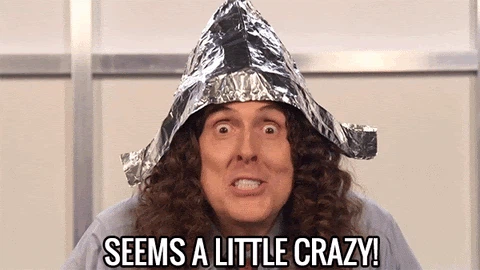Dirty Lies, Clean Food: How Nutrition Labels Are Literally Allowed To Lie To You
We all know unprocessed foods with short ingredient lists are what we should look for when making nutrition decisions, but did you know that even on these short lists can be hidden, toxic ingredients that food corporations aren’t legally required to disclose?

Here’s the down and dirty of what to look for when it comes to hidden toxins in your food, how to protect yourself, and how to be a savvy shopper the next time you walk down the grocery store aisle.

Bleaching Agents
When I say “chlorine,” you most likely think of a summer day spent by the pool and that quintessential pool smell. But what about flour? Probably not, right? You're a normal person after all, just your average, everyday girl who knows chlorine is for swimming, not eating!
Unfortunately, the FDA disagrees. You shouldn't eat Tide pods, but chlorine? It's just a natural part of a balanced diet! Well, an American diet anyways.
“Dough conditioners,” as termed by the FDA, are chemicals used to treat flour in order to age it. This accelerated aging causes bleaching and decreases the flour’s protein and nutrient content. All of this is done to make it form gluten more easily. This advanced gluten formation, in turn, creates the fluffiest of bread and cakes, but it also makes them a food product (rather than a food), as at this point the food product in question isn't exactly beneficial to your overall health and wellness.
Other chemicals like benzoyl peroxide (used in skincare to fight acne), azodicarbonamide (used to make yoga mats, banned in Europe and Australia), and potassium bromate (a class 2B carcinogen, banned in China, India, Brazil, the EU, and Canada) are also still used in the U.S. to bleach flour and to make bread and bread products.
The creepy thing about all of this is, not only does the FDA defend these chemicals being present in our food, if you go and pick up a bag of flour from the store, the bag may say “bleached,” but on the ingredients label, all it says is “flour.” There is no indication as to how the flour was bleached, or with what, or what chemicals might still be lurking within, left over from the bleaching process.
Ohh, and before I forget, just in case you're thinking, ”Well, that's fine. I’ll just buy unbleached flour now,” even unbleached flour is typically brominated. So, even though it's not listed in the ingredients section or sometimes anywhere else on the bag, unbleached flour can still have potassium bromate and azodicarbonamide in it.

Aluminum
Aluminum isn't an ingredient I've ever seen listed on food, heavily processed or otherwise, but that doesn't mean we’re not consuming it.
You see, the FDA has this little thing they like to call GRAS, or “generally recognized as safe.” And, although the FDA does in fact have a minimum risk level of aluminum consumption (as do other organizations such as the Agency for Toxic Substances and Disease Registry of the U.S. Department of Health and Human Services, and the European Food Safety Authority), because aluminum is considered GRAS by the FDA, it’s not required to be on nutrition labels.
So, even though for health reasons you shouldn't consume more than 5mg of aluminum per day, a consumer has no way of tracking their aluminum intake because, though the FDA recognizes too much aluminum isn’t good for you in that aluminum exposure can cause and contribute to Alzheimer's, dementia, autism, encephalopathy, decreased mental development in preterm babies, bone pain, softening of the skeleton, decreased bone mineralization, and central nervous system toxicity, it has assigned it the GRAS label anyways.
The reason the FDA claims aluminum is “safe” (when eaten) is due to the fact that very little is actually absorbed by the digestive system. However, it has been found in the largest meta-analyses to date that “an association between aluminum and Alzheimer disease with long-term high-concentration exposures” has been found. Additionally, according to the CDC, the death rate of Alzheimer's from 1999 to 2019 rose by 81.5%. And here’s the even scarier thing: During that same stretch of time, the obesity rate in America has also increased. But why does that matter? Well, because a high consumption rate of processed foods correlates closely to obesity. And as multiple studies have shown, the foods highest in aluminum are processed foods. In fact, the EPA found that the average American adult consumes 9-30mg of aluminum daily.

Clearly, America has an aluminum problem. While Europe has banned many preservatives and artificial colors that contain aluminum, our country has instead chosen to give them the GMP (or good manufacturing practice) label. So, what can be done? Luckily, the solution is simple – just stay away from processed foods, canned goods, and tap water as much as possible, and you’ll avoid most dietary aluminum.

Citric Acid
A popular ingredient on health food labels and unfortunately one that I frequently wrote off as harmless before I knew any better. Citric = Citrus, I thought. This food company is just distilling a little bit of orange or lemon juice down to make a natural preservative for me. After all, lemon juice is how I keep my apple slices from browning and my homemade guacamole from going bad, so it makes sense. It was an ingredient I felt good about – that is, until I learned that the vast majority of citric acid used in food and food products actually has absolutely nothing to do with citrus fruits, and everything to do with black mold.
Yeah, you heard me right. Every crunchy or silky homeowner’s worst nightmare. Nose bleeds, cancer, constant respiratory infections, brain fog, seizures, body aches, eczema – these are just a few symptoms of black mold exposure. It’s a highly toxic part of our natural world. And where are they putting it? In our “natural” food.
This mutant strain of black mold has been in use since 1919, before the FDA started evaluating the safety of food additives. And when the Food Additives Amendment of 1958 was passed, compelling the FDA to begin investigating food additives for their safety, they investigated Modified Citric Acid and found… Just kidding! They just grandfathered in all food additives in use before 1958 and labeled them (say it with me now) GRAS!
That’s right, according to the FDA, Modified Citric Acid is safe to eat due to the fact that they have never officially studied it! What you don’t know can’t hurt you. At least, according to the FDA. Therefore, this black mold byproduct doesn't have to be labeled as Modified Citric Acid, and instead can just appear on the nutrition label as citric acid. Yum.

Natural Flavor
Did you know that uranium is “all natural”? It is. It’s on the periodic table and everything. So are heavy metals like lead and arsenic. But as we all know, consume enough of any of those things, heck, just stand in the same room with uranium, and you’ll be presented with a painful death. So why then, have we set “natural flavor” on such a high pedestal?
Do you know where the majority of “natural flavor” actually comes from? If it’s raspberry or vanilla flavored, the “natural flavor” listed in the ingredients is most likely not from costly vanilla beans. Ohh no, this isn’t The Great British Baking Show. It’s Snowpiercer, but instead of eating roaches, we’re consuming beaver butt goo. And our rabbit hole doesn't stop there. As it turns out, beaver anal glands are as “natural” as it gets in the world of “natural flavor.” In order for a company to be able to say it uses “natural flavors” in its food product, the flavor in question only has to be derived from something natural. It only has to start out as, let’s say, a lemon. After that, a company can add whatever chemical or preservative it wants to the “lemon” in order to make the flavor or scent stronger. Essentially, “natural flavor” isn’t actually made by nature at all, it’s made in a lab.

Natural Color/Color Added
You may be thinking at this point, “Ok, from now on out, all I have to do to avoid the harmful, hidden toxins in food is to just eat a natural, unprocessed diet and read nutrition labels, but take them with a huge grain of salt.” It's a promising conclusion that any rational girl would come to. Except, do you eat oranges? Because if you do, the FDA is already two steps ahead of you.
Unless you eat only organic oranges or oranges sourced from California and Arizona, you're probably consuming Red No. 2. After non-organic oranges are harvested, they are doused in this colorant and then shipped off to a grocery store near you. And this is a big deal because the vast majority of (possibly all) artificial dyes are toxic in a myriad of different ways to humans. Additionally, there are some studies, as well as parents, that say food dyes trigger psychological changes in children, such as causing or making ADHD symptoms worse.
Now, I know what you’re going to say, and it’s probably something like, “Well, I don’t eat orange peels, so I’m safe,” but unfortunately, au contraire, mon amie. This is because the red dye sprayed on the oranges may be able to be absorbed through its skin and into its flesh, just like many of the pesticides it's been sprayed with. Also, if you eat Red Delicious apples, pickles, blueberries, red potatoes, strawberries, or farmed salmon, you’re probably consuming dye from those sources too.
So, despite the evidence that food dye used on whole foods is more than likely harmful, and is literally a petroleum byproduct, why on earth isn't it being disclosed? Well, it’s because it's a product that, yet again, is considered GRAS by the FDA.
So what about natural colors? Well, remember from earlier, just because it’s natural, doesn't mean it’s safe. Also, how do you feel about eating bugs? I mean, I know the vast majority of us are vehemently against it and we detest organizations like the WEF currently trying to force them down our throats, but what if I told you that you’re probably already eating them?
Carmine is the name the FDA has decided to give to its naturally sourced red dye, and it’s made from cochineal bugs. These hairy, nasty looking insects spend their days sucking the juice from prickly pear cactus pads and then generously give their little lives to dye food products scarlet. You can find them on nutrition labels listed under several names such as Carmine, Cochineal, Cochineal extract, Carminic acid, Natural Red 4, Crimson lake, and Carmine lake. It’s almost like they want it to be confusing, but you get the picture: If you’ve eaten anything naturally dyed red, you’ve probably eaten bugs. Yaaaaaay.
The FDA has this to say about its own natural colors: “Color additives exempt from certification generally include those derived from plant or mineral sources. … Certification exempt color additives must comply with the identity and purity specifications and use limitations described in their listing regulations. Users of these color additives are responsible for ensuring that the color additives comply with the listing regulations.” In short, the FDA doesn’t really regulate natural colorants. It doesn’t test them to ensure they are what they say they are. The company putting them in your food does, and that's all just a little too sus for me.

Glyphosate, a.k.a. Roundup Weed Killer
It’s a carcinogen, neurotoxin, endocrine disruptor and more, but you won’t find it listed on any ingredients label even though just by consuming non-organic food, you are also consuming this pesticide (and others).
It feels like organic should be the standard when pesticides are so harmful to our health, and it also feels like because pesticides pose such a threat, eating all organic all the time should at least be affordable. Unfortunately, though, that’s just not the world we live in. The good news is, however, that by avoiding the most pesticide laden foods, we can actually cut way down on our toxic load. Here’s how to do it.
First off, there is a standard set by the EPA for the “maximum residue limit” (MRL) of glyphosate residue allowed on food and food products, and according to the FDA, “The FDA’s role is to ensure that pesticide chemical residues on or in domestic and imported foods do not exceed the limits established by the U.S. Environmental Protection Agency (EPA).” However…

Big Food doesn't really care and neither does the FDA, and according to the EWG, the MRL set by the EPA of 100-400,000ppb isn't low enough to keep humans safe, so, even though you think you may be consuming a “safe” level of pesticides, you may in fact accidentally be predisposing yourself to cancer as per JAMA (who found that diets high in organic foods are associated with a lower cancer risk) and the International Agency for Research on Cancer (that claims glyphosate is “probably carcinogenic”).
Fortunately for us, the EWG has whistle blown on companies whose food products contain massive doses of glyphosate (looking at you Quaker and General Mills) as well as taken the time to test certain foods and compile a list called “the dirty dozen” by which we can avoid (through buying organic) some of the most heavily contaminated foods. It’s not a perfect solution, by any means, but fortunately, according to recent studies, in terms of pesticide reduction, a little goes a long way.
Closing Thoughts
The FDA’s definition of natural and ours is extremely different. According to the FDA, beaver butt glands, insects, black mold, glyphosate, and aluminum are all a harmless and “natural” part of every American’s diet. But I’m not so sure.
Americans seem to be plagued by diet fed disease states at a rate much higher than other countries. Maybe it’s time the FDA got rid of its GRAS label and forced Big Food to tell the truth so that consumers can actually make informed decisions.
If a company feels the necessity to lie through omission just to net people into buying their product, maybe it’s not an ingredient that should be there in the first place.
Love Evie? Sign up for our newsletter and get curated content weekly!